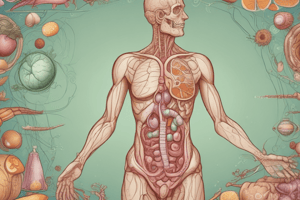Podcast
Questions and Answers
What defines a positive nitrogen balance?
What defines a positive nitrogen balance?
- Total Daily Nitrogen Losses < Total Daily Nitrogen Intake (correct)
- Total Daily Nitrogen Losses = Total Daily Nitrogen Intake
- Total Daily Nitrogen Losses > Total Daily Nitrogen Intake
- Total Daily Nitrogen Intake < Total Daily Nitrogen Losses
In which condition is negative nitrogen balance most likely to occur?
In which condition is negative nitrogen balance most likely to occur?
- Adults undergoing recovery from illness
- Healthy children gaining weight
- Individuals experiencing starvation (correct)
- Athletes in intense training
What percentage of total urinary nitrogen in a protein-rich diet is urea nitrogen?
What percentage of total urinary nitrogen in a protein-rich diet is urea nitrogen?
- 87.9% (correct)
- 86.1%
- 69.1%
- 100%
What is the main form of disposal for amino groups derived from amino acids in the body?
What is the main form of disposal for amino groups derived from amino acids in the body?
What percentage of nitrogen-containing components of urine is urea responsible for?
What percentage of nitrogen-containing components of urine is urea responsible for?
In a normal protein intake diet, what is the nitrogen contribution from creatinine?
In a normal protein intake diet, what is the nitrogen contribution from creatinine?
Which of the following statements about nitrogen balance is accurate?
Which of the following statements about nitrogen balance is accurate?
Which nitrogenous waste has the highest percentage representation in a protein-poor diet?
Which nitrogenous waste has the highest percentage representation in a protein-poor diet?
What is the total urinary nitrogen excretion (in grams) for a protein-rich diet?
What is the total urinary nitrogen excretion (in grams) for a protein-rich diet?
Where does the urea cycle primarily take place in the body?
Where does the urea cycle primarily take place in the body?
What percentage of total urinary nitrogen is contributed by ammonia nitrogen in a normal protein intake diet?
What percentage of total urinary nitrogen is contributed by ammonia nitrogen in a normal protein intake diet?
What is the typical daily nitrogen loss for an individual weighing 70 kg?
What is the typical daily nitrogen loss for an individual weighing 70 kg?
In the context of a protein-poor diet, which nitrogen compound has a lower excretion rate in grams than creatinine nitrogen?
In the context of a protein-poor diet, which nitrogen compound has a lower excretion rate in grams than creatinine nitrogen?
Which of the following is a consequence of a negative nitrogen balance?
Which of the following is a consequence of a negative nitrogen balance?
How much urea nitrogen is found in a protein-poor diet (in grams)?
How much urea nitrogen is found in a protein-poor diet (in grams)?
Which nitrogen form has the lowest contribution to total urinary nitrogen across all diets presented?
Which nitrogen form has the lowest contribution to total urinary nitrogen across all diets presented?
What is the primary role of arginase in the urea cycle?
What is the primary role of arginase in the urea cycle?
Which characteristic of urea makes it suitable for excretion in urine?
Which characteristic of urea makes it suitable for excretion in urine?
What is the fate of ornithine after its formation in the urea cycle?
What is the fate of ornithine after its formation in the urea cycle?
What is the function of N-acetylglutamate in urea cycle regulation?
What is the function of N-acetylglutamate in urea cycle regulation?
How does the concentration of arginine influence urea synthesis post protein-rich meals?
How does the concentration of arginine influence urea synthesis post protein-rich meals?
How is N-acetylglutamate transported from the liver after its synthesis?
How is N-acetylglutamate transported from the liver after its synthesis?
What happens to urea after it enters the blood from the liver?
What happens to urea after it enters the blood from the liver?
What is the significance of the solubility of urea in biochemical processes?
What is the significance of the solubility of urea in biochemical processes?
What are the two sources of nitrogen that contribute to the formation of urea?
What are the two sources of nitrogen that contribute to the formation of urea?
Which enzyme deficiency is associated with Type I Hyperammonemia?
Which enzyme deficiency is associated with Type I Hyperammonemia?
What metabolic byproduct results from the urea cycle in addition to urea?
What metabolic byproduct results from the urea cycle in addition to urea?
Which condition is characterized by a defect in argininosuccinate lyase?
Which condition is characterized by a defect in argininosuccinate lyase?
During urea synthesis, how many high-energy phosphates are consumed?
During urea synthesis, how many high-energy phosphates are consumed?
What is a potential consequence of hyperammonemia?
What is a potential consequence of hyperammonemia?
Which symptom is NOT typically associated with diseases involving urea cycle defects?
Which symptom is NOT typically associated with diseases involving urea cycle defects?
How does the urea cycle help in nitrogen disposal?
How does the urea cycle help in nitrogen disposal?
What immediate precursor of glutamate is involved in oxidative deamination?
What immediate precursor of glutamate is involved in oxidative deamination?
What is the result of the irreversible nature of urea synthesis?
What is the result of the irreversible nature of urea synthesis?
What condition is primarily associated with the shift in the equilibrium of the glutamate dehydrogenase reaction toward glutamate formation?
What condition is primarily associated with the shift in the equilibrium of the glutamate dehydrogenase reaction toward glutamate formation?
What is the main consequence of decreased a-ketoglutarate levels due to high concentrations of ammonia?
What is the main consequence of decreased a-ketoglutarate levels due to high concentrations of ammonia?
High levels of ammonia can lead to coma and death primarily due to disruptions in what metabolic cycle?
High levels of ammonia can lead to coma and death primarily due to disruptions in what metabolic cycle?
Which of the following conditions is NOT a direct cause of acquired hyperammonemia?
Which of the following conditions is NOT a direct cause of acquired hyperammonemia?
The formation of collateral circulation around the liver is primarily associated with which condition?
The formation of collateral circulation around the liver is primarily associated with which condition?
What is a key factor that makes the brain particularly vulnerable to the effects of hyperammonemia?
What is a key factor that makes the brain particularly vulnerable to the effects of hyperammonemia?
Which of the following is a consequence of portal blood shunting into systemic circulation due to liver disease?
Which of the following is a consequence of portal blood shunting into systemic circulation due to liver disease?
What biochemical process is primarily altered due to elevated ammonia levels during liver disease?
What biochemical process is primarily altered due to elevated ammonia levels during liver disease?
Study Notes
Nitrogen Disposal Overview
- Total urinary nitrogen varies by protein intake: normal (13.2 g), protein-poor (23.28 g), protein-rich (42 g).
- Urea nitrogen represents a significant portion of urinary nitrogen (86.1% in normal diet).
- Other nitrogenous compounds in urine include ammonia (3%), creatinine (4.6%), uric acid (1.6%), and undetermined nitrogen (4.7%).
Positive and Negative Nitrogen Balance
- Positive Nitrogen Balance: Daily nitrogen losses are less than intake, commonly found in growing children and recovering adults.
- Negative Nitrogen Balance: Daily nitrogen losses exceed intake, seen in conditions like tissue wasting and starvation; can lead to dangerous protein loss.
Urea Cycle
- Urea cycle occurs exclusively in the liver and is essential for nitrogen disposal.
- Urea serves as the main form to excrete nitrogen derived from amino acids (90% of nitrogen in urine).
- Arginase is pivotal for urea synthesis, primarily acting within the liver.
Urea Composition and Synthesis
- Urea synthesis involves combining ammonia, aspartate, bicarbonate, and ATP to produce urea and fumarate.
- Nitrogen in urea is sourced from free ammonia and aspartate; glutamate contributes indirectly via oxidative deamination and transamination.
Urea Cycle Regulation
- N-Acetylglutamate (NAG) is essential for activating carbamoyl phosphate synthetase I (CPS I), which initiates the urea cycle.
- NAG increases the affinity of CPS I for ATP, optimizing urea synthesis.
Genetic Defects and Disorders
- Genetic defects in urea cycle enzymes can lead to severe conditions:
- Type I Hyperammonemia: Carbamoyl phosphate synthetase defect.
- Type II Hyperammonemia: Ornithine transcarbamoylase defect.
- Citrullinuria: Argininosuccinate synthase defect.
- Argininosuccinic Acidemia: Argininosuccinate lyase defect.
- Hyperargininemia: Arginase defect.
- Symptoms of these defects include hyperammonemia, which can cause toxic ammonia accumulation leading to brain damage and episodic encephalopathies (e.g., convulsions, ataxia).
Mechanism of Ammonia Toxicity
- High ammonia levels can cause coma and death, severely affecting cellular metabolism.
- Acquired hyperammonemia is linked to liver disease (viral hepatitis, ischemia).
- TCA cycle intermediates (like α-ketoglutarate) become depleted with elevated ammonia, hampering ATP production, especially in the brain, which has high energy demands.
These notes encapsulate the critical components of nitrogen disposal relating to amino acids and associated metabolic pathways.
Studying That Suits You
Use AI to generate personalized quizzes and flashcards to suit your learning preferences.
Related Documents
Description
This quiz explores the critical processes of nitrogen disposal, including urinary nitrogen variations with protein intake and the implications of positive and negative nitrogen balance. It also delves into the urea cycle's role in nitrogen excretion, focusing on liver functions and key enzymes involved. Test your knowledge on these essential biochemical concepts!




